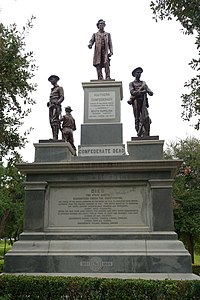| Confederate Soldiers Monument | |
|---|---|
 The monument in 2015 | |
 | |
| Artist | |
| Year | 1903 |
| Medium | Sculpture |
| Location | Austin, Texas, United States |
| 30°16′23″N97°44′27″W / 30.273111°N 97.740792°W | |
| Owner | Texas State Preservation Board |
The Confederate Soldiers Monument, also known as the Confederate Dead Monument, is a Confederate memorial installed outside the Texas State Capitol in Austin, Texas. [1] [2] It was erected in 1903. Its sculpture was designed by Pompeo Coppini, and its base was designed by Frank Teich. [3] The sculpture was cast by Roman Bronze Works (New York City).
Contents
The monument consists of five bronze figures on the base that represent the Confederate Military: Infantry, Cavalry, Artillery and Navy. [4] At the top of the monument standing far above the other figures is Jefferson Davis, the President of the Confederate States. [4]
Alongside 11 other Confederate monuments at the capitol, it was largely funded by United Daughters of the Confederacy, a group of women descended from Confederate soldiers. [5]